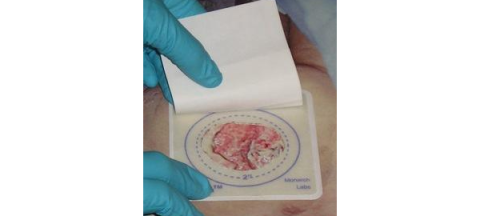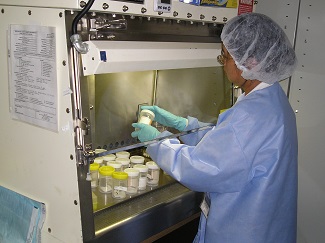Bagged and Free-Range: How Different Maggot Therapy Dressings Work
August 27, 2015
I have been avoiding the topic of addressing the differences between contained (bagged) versus confined (non-bagged or "free-range") maggot therapy because I haven't wanted to take a position in affairs that affect specific companies' products. In addition, I have a conflict of interest in that I run a laboratory that produces one type of dressing and not the other. Nevertheless, I have been dragged involuntarily into this conversation by the hoards of people who ask me about the data and information surrounding the application of maggots in containment bags. Indeed, I may even have an obligation to share my thoughts, given my role in the maggot therapy movement, and given that I have experience in testing and using both techniques. So with that understanding, let's begin by exploring the maggot dressing options currently available. The terminology can be a bit confusing so we should begin there.
Maggot dressings are intended to maintain the medicinal maggots on the wound in a manner that is acceptable to both the patient and therapist. Medicinal maggots are self-extracting: once they are satiated or have removed all of the necrotic tissue they will instinctively leave the wound. Accordingly, maggot dressings are used to keep the maggots from wandering off before the therapist can appropriately dispose of them (in a biohazardous waste bag, like other wound dressing waste). The dressings are usually made from a netted fabric to allow air to freely reach the larvae, and to facilitate drainage of the liquefied necrotic tissue. Maggots dissolve the necrotic tissue so quickly that they can not suck it all up, and if it is not allowed to drain from the wound it could drown the maggots or macerate the skin. There are now two general types of maggot dressings: confinement dressings and containment dressings.
Confinement (Free-Range) Maggot Therapy Dressings
Confinement dressings restrict the maggots to the wound area, but allow them complete and free access to the wound tissue. Confinement dressings are the maggot therapy dressing method used for nearly 100 years. They are sometimes referred to as "cage dressings," or "free range" maggot dressings. These dressings usually are comprised of a foundation or "fence" on the skin that surrounds the wound, topped by a porous polyester net. The maggots are placed inside (at a dose of 5–10 larvae/cm2 ) along with some light moist gauze, before sealing this dressing cage with the netted fabric roof. Confinement dressings can be constructed at the bedside from readily available materials (Sherman et al. 1996 ; Sherman 1997) or maggot-specific dressings can be purchased readymade (i.e., LeFlap™ and LeSoc™ by Monarch Labs, California).
Containment (Bagged) Maggot Therapy Dressings
Containment dressings (sometimes called "bagged maggots" or "tea bag" maggots) differ from confinement dressings in that the net dressing completely surrounds or envelops the maggots (Grassberger and Fleischmann 2002). Contained maggots are supplied already sealed within the containment bags, constructed from simple polyester net (e.g. Biobag™ by BioMonde [Bridgend, Wales]) or from polyvinyl alcohol foam (Vitapad™, by BioMonde).
Whether the therapist uses contained or confined dressings, a secondary dressing is applied to absorb the liquefying, draining necrotic tissue. This secondary dressing can be changed when soiled, but the primary maggot dressing is left in place for the duration of the treatment cycle: about two days for confined ("free-range") maggots or four days for contained ("bagged") maggots.
Bagged maggots hit the U.S. market in December 2014. They have been used in Europe for over a dozen years, but for legal reasons they could not be distributed in the United States until the UK-based company that owns the patent rights decided it was time to obtain FDA marketing clearance and begin distributing their product in this country. Make no mistake about it: I am glad bagged maggots are finally available. I have used them, and I even had the privilege of contributing to their development. But in order to use bagged maggots optimally --- like any other wound care product --- it is crucial to understand their indications, advantages, and limitations. I have used or recommended bagged maggots in fewer than 1% of my patients; but in those cases, I felt they were invaluable.
Future blog posts will provide further discussion on confinement and containment maggot therapy dressings with a closer look at the indications and data for the different types of dressings.
Disclosure: Financial - The author is Co-founder and Laboratory Director of Monarch Labs.
Image Credit: Photo by R.A. Sherman, courtesy of Monarch Labs, LLC.
References:
Grassberger M, Fleischmann W. The biobag - a new device for the application of medicinal maggots. Dermatology. 2002;204:306.
Sherman RA. Mechanisms of maggot-induced wound healing: what do we know, and where do we go from here? Evid Based Complement Alternat Med. 2014;2014:592419.
Sherman RA. A new dressing design for use with maggot therapy. Plast Reconstr Surg. 1997;100:451-6.
Sherman RA, Tran JM, Sullivan R. Maggot therapy for venous stasis ulcers. Arch Dermatol. 1996;132:254-6.
Steenvoorde P, Jacobi CE, Oskam J. Maggot debridement therapy: free-range or contained? An in-vivo study. Adv Skin Wound Care. 2005;18:430-5.
About The Author
Ron Sherman MD, MSC, DTM&H has led a long career at the forefront of biotherapy, pioneering the development of medicinal maggots for over 25 years. He is now retired from his faculty position at the University of California, but continues to volunteer as Director and Board Chair of the BTER Foundation, and as Laboratory Director of Monarch Labs.
The views and opinions expressed in this content are solely those of the contributor, and do not represent the views of WoundSource, HMP Global, its affiliates, or subsidiary companies.










